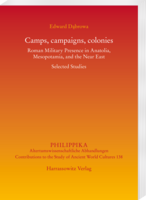|
|
more titles of the subject:
Download:
Please note: With adding digital Products to your cart
the payment will be handled via PayPal. The download will be provided after the payment is confirmed. Owing to the threat posed by the Parthian state, and later the Sasanid state, defence of the eastern border of the Roman Empire demanded the presence of considerable military forces. In this respect, Anatolia, Mesopotamia and the Near East were particularly significant in Rome’s defensive policy. Numerous military camps were situated in this region, from which the Romans undertook military expeditions against their eastern neighbour. The outcomes of the long-term presence of a large number of Roman army units there included settlement of veterans in both the colonies and the cities of the region.
The volume contains a selection of studies by Edward Dąbrowa published over several decades concerning certain aspects of the presence of the Roman army in the East. These concern issues related to Roman military camps and campaigns as well as military colonisation in the post-Hadrian period in Mesopotamia, Syria and Judaea. The existence of this colonisation has long been questioned by many scholars. The studies in this book present arguments showing that such colonisation did take place, albeit on a limited scale. It was used on a larger scale mostly by emperors from the Severan dynasty, but also later ones, at least until the mid-third century CE, as a means of urbanisation of these areas. |
|||||||||||||||||||||||||||||||||||||||






